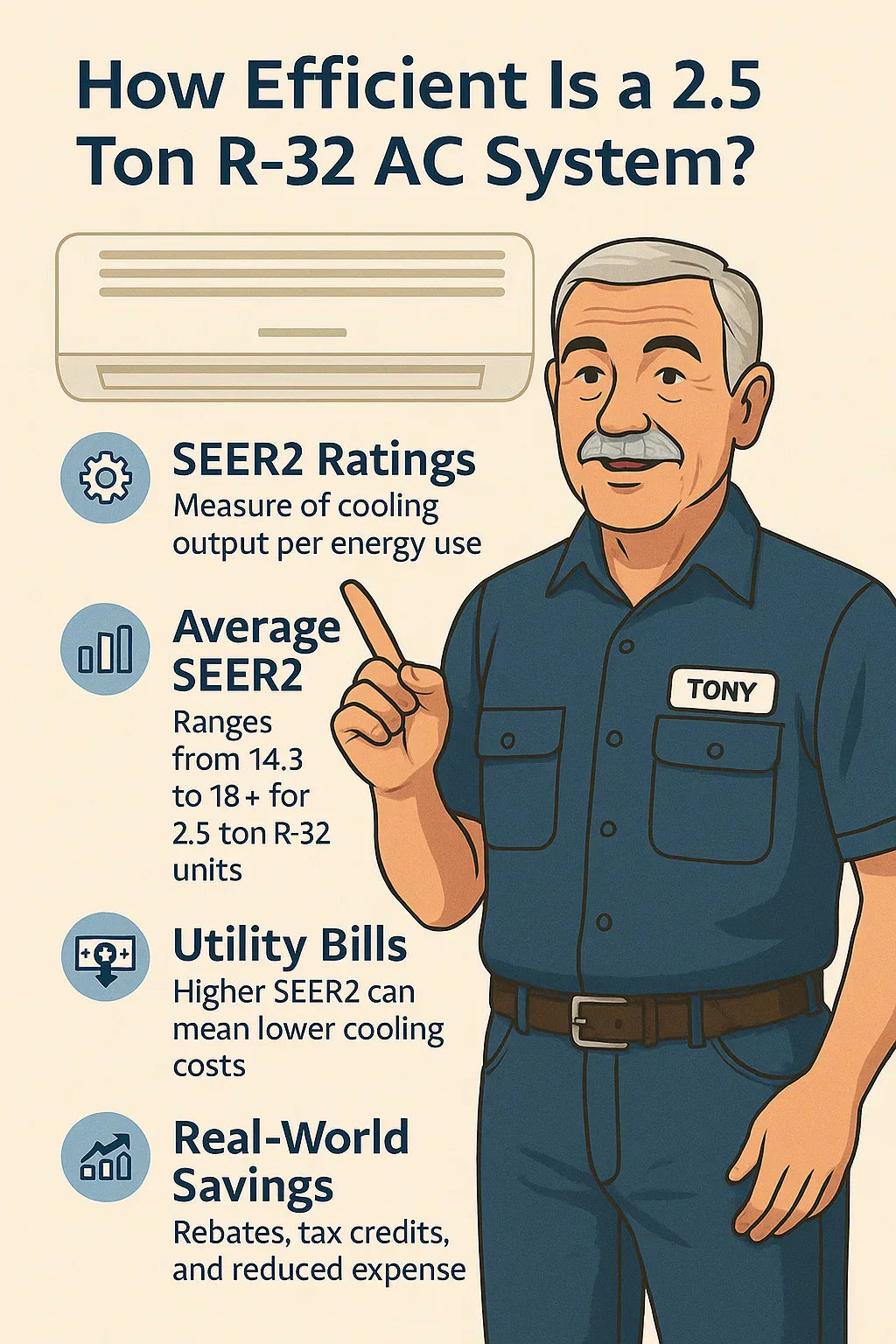If you're shopping for a new AC in 2025, there’s a good chance you’ve come across systems using R-32 refrigerant. And if you’re like Tony, a practical, value-driven homeowner, you’re probably asking one big question:
“Will a 2.5 ton R-32 AC system really save me money in the long run?”
In this guide, we break down how SEER2 efficiency ratings work, how much energy a 2.5 ton R-32 system uses, and what you can expect in terms of monthly utility bills and real-world savings.
🧊 What Does Efficiency Mean in a 2.5 Ton AC System?
❓ What is SEER2?
SEER2 stands for Seasonal Energy Efficiency Ratio 2—the updated 2023 standard that reflects how efficiently an air conditioner performs under real-world conditions.
The formula: SEER2 = Total Cooling Output (BTUs) / Total Energy Used (Watt-Hours)
The higher the SEER2 rating, the more efficient the system.
-
14.3 SEER2 = baseline minimum in southern U.S. (formerly ~15 SEER)
-
16–18 SEER2 = high-efficiency range for Energy Star-qualified systems
📊 SEER2 Ratings for 2.5 Ton R-32 Systems
Most R-32 AC systems in the 2.5 ton size fall into one of these tiers:
| Efficiency Tier | SEER2 Range | Common Use Case |
|---|---|---|
| Standard | 14.3 SEER2 | Meets federal code, entry-level systems |
| High Efficiency | 16–17 SEER2 | Most Energy Star rated systems |
| Premium | 18+ SEER2 | Zoned homes or climates with heavy usage |
R-32 systems tend to score better than their R-410A counterparts in the same size because:
-
R-32 has better thermal conductivity
-
Uses less refrigerant by weight
-
Works with smaller coils and improved compressor tech
💸 Real-World Utility Bill Comparisons
Let’s use Tony’s home as an example:
-
1,500 sq. ft.
-
Located in Zone 3 (mixed climate, like Tennessee or Kansas)
-
Uses AC from May through September
Estimated Monthly Cooling Costs by SEER2
| SEER2 Rating | Estimated Monthly Cooling Cost |
| 14.3 SEER2 | $110/month |
| 16 SEER2 | $95/month |
| 18 SEER2 | $85/month |
That's a potential $300+ per year in savings by going from standard to high-efficiency. Over 10 years, that’s $3,000+ back in Tony’s pocket.
🌿 How R-32 Boosts System Efficiency
R-32 doesn’t just help the environment—it also helps your wallet.
Benefits vs. R-410A:
-
Heat transfer efficiency: R-32 cools air faster using less energy
-
Lower refrigerant charge: Up to 30% less needed
-
Supports higher SEER2 ratings: More efficient overall
Combined with a variable-speed compressor, R-32 systems are often 10–20% more efficient under partial load conditions—when most ACs run.
🧱 What Factors Affect Real-World Efficiency?
Even with a high-SEER2 system, these real-life variables will impact Tony’s savings:
-
Duct leakage: Can drop actual efficiency by up to 30%
-
Thermostat usage: Poor programming wastes cooling cycles
-
Window shading & insulation: Reduce interior heat gain
-
Installation quality: Improper refrigerant charge = lower efficiency
🎯 Tax Credits & Rebates in 2025
High-efficiency R-32 systems may qualify for:
-
✅ 25C Federal Tax Credit: Up to $600 for qualifying AC units
-
✅ State utility rebates: Often $150–$500 for systems rated 16+ SEER2
-
✅ Local programs: Based on electric utility efficiency incentives
📈 ROI: When Will Tony Break Even?
Let’s assume Tony pays $500 more for a 16 SEER2 R-32 system over a base 14.3 SEER2 model.
| Item | Value |
| Annual savings | ~$180 |
| Payback period | ~2.8 years |
| 10-year savings | ~$1,800 |
| 15-year savings | ~$2,700+ |
When utility rates rise (as expected), that breakeven point shortens further.
✅ Summary: Should You Go High-Efficiency with R-32?
If you:
-
Live in a moderate to warm climate
-
Use AC 5+ months per year
-
Want to cut electric bills
-
Care about environmental impact
... then a 2.5 Ton R-32 AC system with 16+ SEER2 is a smart long-term investment.
💡 Browse The Furnace Outlet’s 2.5 Ton R-32 Collection for high-efficiency models.
In the next topic we will know more about: Installation Considerations for a 2.5 Ton R-32 AC: Space, Ducting & Electrical Readiness







